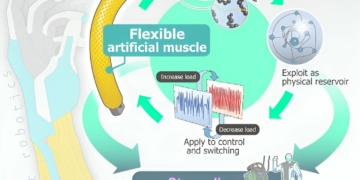Summary: When reaching for a target object, we anchor our gaze to the target of the reach moment, thereby looking at the target for longer periods. This helps make our reach more accurate.
Source: NYU
Keeping our eyes focused on what we reach for, whether it be an item at the grocery store or a ground ball on the baseball field, may appear seamless, but, in fact, is due to a complex neurological process involving intricate timing and coordination.
In a newly published study in the journal Nature, a team of researchers sheds additional light on the machinations that ensure we don’t look away from where we are reaching.
The work centers on a form of coordinated looking and reach called “gaze anchoring”—the temporary stoppage of eye movements in order to coordinate reaches.
“Our results show that we anchor our gaze to the target of the reach movement, thereby looking at that target for longer periods,” explains Bijan Pesaran, a professor at NYU’s Center for Neural Science and one of the paper’s authors.
“This is what makes our reaches much more accurate. The big question has been: How does the brain orchestrate this kind of natural behavior?”
The study, conducted with Maureen Hagan, a neuroscientist at Australia’s Monash University, explores the frequently studied but not well understood process of gaze anchoring—in particular, how different regions of the brain communicate with each other.
To examine this phenomenon, the scientists studied brain activity in the arm and eye movement regions of the brain at the same time as non-human primates performed a sequence of eye and arm movements.
The first movement was a coordinated look-and-reach to a target. Then, as little as 10 milliseconds later, a second target was presented that subjects needed to look at as quickly as possible.
This second eye movement revealed the gaze anchoring effect.
These movements are similar to those made when changing the radio while driving and attending to a traffic light—if you quickly look away from the radio to the traffic light, you might not select the right channel.
Their results showed that, during gaze anchoring, neurons in the part of the brain—the parietal reach region—used for reaching work to inhibit neuron activity in the part of the brain—the parietal saccade region—used for eye movements.


This suppression of neuron firing serves to inhibit eye movement, keeping our eyes centered on the target of our reach, which then enhances the accuracy of what we’re grasping for. Importantly, the scientists note, the effects were tied to patterns of brain waves at 15-25 Hz, called beta waves, that organize neural firing across the different regions of the brain.
“Beta waves have been previously linked to attention and cognition, and this study reveals how beta activity may control inhibitory brain mechanisms to coordinate our natural behavior,” explains Pesaran.
By further illuminating the neurological processes of coordinated looking and reaching, tying them to inhibitory beta waves, this study offers the potential to better understand afflictions of attention and executive control that orchestrate natural behaviors like coordinated looking and reaching.
Funding: The research was supported by the National Institutes of Health (T32 EY007136), Australian Research Council (DE180100344), the National Science Foundation (BCS-0955701), the National Eye Institute (R01-EY024067), the Army Research Office, the Simons Foundation, a McKnight Scholar Award, and a Sloan Research Fellowship.
About this visual neuroscience research news
Author: James Devitt
Source: NYU
Contact: James Devitt – NYU
Image: The image is credited to NYU
Original Research: Closed access.
“Modulation of inhibitory communication coordinates looking and reaching” by Maureen Hagan et al. Nature
Abstract
Modulation of inhibitory communication coordinates looking and reaching
Looking and reaching are controlled by different brain regions and are coordinated during natural behaviour.
Understanding how flexible, natural behaviours such as coordinated looking and reaching are controlled depends on understanding how neurons in different regions of the brain communicate. Neural coherence in a gamma-frequency (40–90 Hz) band has been implicated in excitatory multiregional communication.
Inhibitory control mechanisms are also required to flexibly control behaviour, but little is known about how neurons in one region transiently suppress individual neurons in another to support behaviour. How neuronal firing in a sender region transiently suppresses firing in a receiver region remains poorly understood.
Here we study inhibitory communication during a flexible, natural behaviour, termed gaze anchoring, in which saccades are transiently inhibited by coordinated reaches. During gaze anchoring, we found that neurons in the reach region of the posterior parietal cortex can inhibit neuronal firing in the parietal saccade region to suppress eye movements and improve reach accuracy.
Suppression is transient, only present around the coordinated reach, and greatest when reach neurons fire spikes with respect to beta-frequency (15–25 Hz) activity, not gamma-frequency activity.
Our work provides evidence in the activity of single neurons for a novel mechanism of inhibitory communication in which beta-frequency neural coherence transiently inhibits multiregional communication to flexibly coordinate natural behaviour.

















